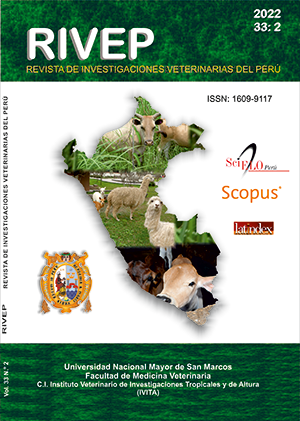Determination of Salmonella enterica in biologically appropriate raw food for dogs (BARF) in Lima, Perú
DOI:
https://doi.org/10.15381/rivep.v33i2.22578Keywords:
BARF food, Salmonella enterica, food poisoning, bacteria, bacterial contaminationAbstract
The study aimed to determine the frequency and antibiotic resistance of Salmonella enterica isolated from biologically appropriate raw food (BARF) for dogs in Lima, Peru. In total, 124 samples belonging to 13 brands and batches of BARF-type food available in the local market were collected. The samples were transported in a cooler at 4 °C and kept frozen -18 °C until processing. Bacterial isolation and identification were carried out through biochemical tests, to finally determine antimicrobial resistance against 16 antibiotics. The frequency of S. enterica was 55.6 + 8.7% (69/124), with a statistical association (p<0.05) between the presence of Salmonella and the BARF-type food brand. No significant association (p>0.05) was found between the type of meat in the food and the diagnosis of S. enterica. The results showed 81.5% of S. enterica strains were resistant, 11.6% showed intermediate resistance, and 7.4% were sensitive to antibiotics. S. entérica has a high frequency in BARF food for dogs marketed in Lima.
Downloads
Downloads
Published
Issue
Section
License
Copyright (c) 2022 Kely Espinoza-Garate, Siever Morales-Cauti

This work is licensed under a Creative Commons Attribution 4.0 International License.
AUTHORS RETAIN THEIR RIGHTS:
a. Authors retain their trade mark rights and patent, and also on any process or procedure described in the article.
b. Authors retain their right to share, copy, distribute, perform and publicly communicate their article (eg, to place their article in an institutional repository or publish it in a book), with an acknowledgment of its initial publication in the Revista de Investigaciones Veterinarias del Perú (RIVEP).
c. Authors retain theirs right to make a subsequent publication of their work, to use the article or any part thereof (eg a compilation of his papers, lecture notes, thesis, or a book), always indicating the source of publication (the originator of the work, journal, volume, number and date).










